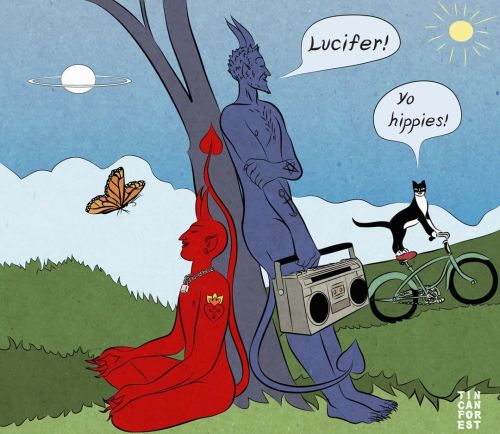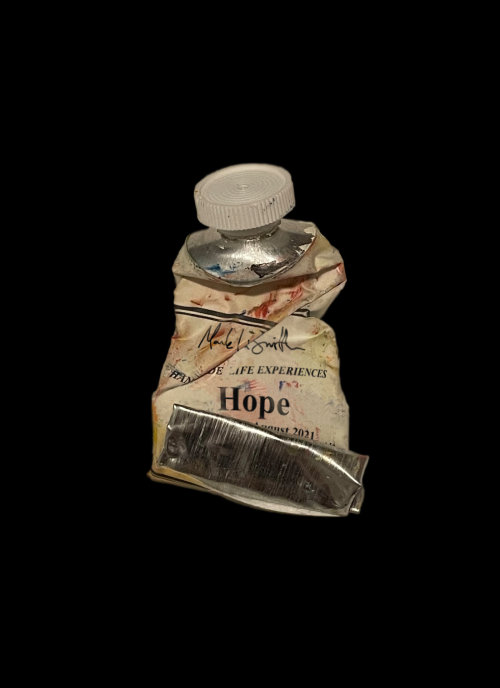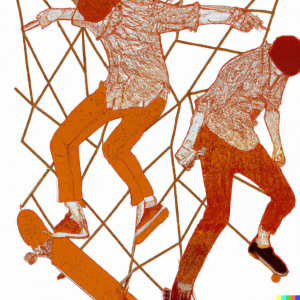October! Pumpkins! The increasingly-heated domestic arguments about when, exactly, you are allowed to start looking longingly at the thermostat! Yes, that’s right, WE’RE INTO THE HOME STRAIGHT OF 2022! Basically from hereon in it’s just waiting for Christmas party season and for mulled wine to become an acceptable breakfast drink (third week of this month, fyi), and trying not to think too hard about all the people who are inevitably going to top themselves over the coming months as the relentless barrage of YOU WILL HAVE FUN IT’S THE MOST MAGICAL TIME OF THE YEAR collides hard with the dawning reality of ‘Great’ Britain in the modern age and how it costs not to die these days.
Still, that’s still to come – in the here and now we can still distract ourselves with shiny digital gewgaws, and so to that end let me present to you this week’s bulging haul of internet ephemera with which to delight and soothe. If you can’t find something in here to amuse you then, well, what the fcuk is wrong with you, frankly.
I am still Matt, this is still Web Curios, and I promise to be cheerier in next week’s upfront.

THE SECTION WHICH THIS WEEK HAS HAD HORRIBLE FLASHBACKS TO THE TIME IT HAD TO DO ALL THREE PARTY CONFERENCES BACK-TO-BACK IN THE EARLY-00s AND WHICH ON REFLECTION REALISES THAT SOMETHING IMPORTANT INSIDE IT DIED AS A RESULT, PT.1:
- The MetaOcean: I think I made some sort of half-promise to myself (I would never promise anything to you) a few months ago that I would attempt not to feature stuff in here for the sole purpose of giving it a kicking – after all, Web Curios is intended to be a celebration of the wonderful world of creative webwork and the kaleidoscopic cornucopia (can a cornucopia be kaleidoscopic? I feel I have lost control slightly here and it’s only the first link of the morning ffs) of idiosyncratic human interests! Positive vibes only! No haters! I was doing pretty well, I think, and then this floated into my field of vision and, well, I cracked slightly. THIS IS THE SH1TTEST THING YET TO BE BRANDED METAVERSAL AND EVERYONE INVOLVED IN ITS CREATION SHOULD FEEL SOME SMALL FRISSON OF SHAME AT ITS, AND BY EXTENSION THEIR, EXISTENCE. I have no idea whatsoever why it exists or what it is meant to prove, or exactly who the doubtless-clever people at Vogue think wants to explore a digital ocean in order to browse some low-quality CG artworks, or exactly what a single, browser-based 3d…thing has to do with the concept of ‘the metaverse’. You can, if you like, read more about the project here – it won’t make any sense of it, but you will get to experience sentences like this one: “the experience includes an above-water exploration followed by a mythical underwater world, featuring work by 24 artists including 3D digital sculptures, nominated by editorial teams from global Vogue titles including India, Australia, Mexico and Latin America, Japan and China.” So that’s nice. Honestly, I can’t stress enough how mesmerisingly-terrible this is – you click through, choose whether you want to explore the above-water or underwater METAOCEAN, and then pilot a small digital vessel with your WASD keys as you gaze at some poorly-rendered digital ‘art’ while your laptop wheezes like an emphysematic. The thing takes ages to load, the lag when it does is horrible, clicking on any of the artworks screws your ability to then move around…none of it works, which when you consider that this is Vogue, and therefore meant to be quite shiny and high-end, feels a bit…embarrassing. Who signed this off? Is the person at the digital agency who built this sleeping with or related to someone in commissioning? Does Anna know?! Honestly, I can’t stress enough how majestically crap this is – if you have ever been involved in the creation of a slightly-rubbish digital thing and want something to make you feel better about your professional failings, this will salve your pride. This will have cost Vogue six figures, no doubt, for something that looks and feels like a cover-mounted CD demo from Playstation World in 2004. Still, at some point in the future you’ll be able to buy NFTs in the MetaOcean, so that’s nice.
- Petaverse: Thanks to Alex Fleetwood for alerting me to this – he actually sent it to me last week, but it took me a while to come to terms with its brilliance. Petaverse (DO YOU SEE WHAT THEY DID THERE DO YOU SEE?) is a company which is ‘on a mission to bring your bestest animal friend to the magical world of web3’, and if that bit of copy doesn’t make you want to apply a cheesegrater to the shins of everyone involved in the project then, well, you’re a better person than I am. Send them a picture of your pet (oh, and 0.15ETH, currently about 1200 quid) and they will make you a digital version of it! As an NFT! Which you can then use in non-specified future digital ways (honest, guv!)! Look, whatever you want to do with your pet is up to you, but it’s worth pointing out that you can probably get it taxidermied for less than the cost of turning into a low-poly Nintendog.
- Hume: I imagine that you, like me, spend much of your waking time on this fast-decaying planet thinking to yourself ‘Hmm, which of the current trappings of Western civilisation and culture would I most like to see ported to the glorious-if-entirely-theoretical metaversal future that we are being peddled by our tech overlords?’ – and I imagine that, also like me, you regularly think ‘yes, that’s it, RECORD LABELS! I want record labels in the metaverse!”. Well, it’s your LUCKY DAY, as Hume is apparently just that thing – the world’s first metaversal record label! Specifically, Hume is “a record label built for the future. A collective fueled by metastars. We are reshaping what it means to be an artist, what it means to be a fan.” What that means in practice is (and this may not come as a huge surprise to you) unclear, but seems to involve a whole load of largely-incomprehensible lore about a digital artist from the future called Angelbaby who has traveled back in time to save music and can only do so by, er, setting up a company designed to explore exciting new artist monetisation possibilities via the medium of NFTs. A brief aside – apart from the fact that ALL THIS STUFF IS FCUKING BULLSHIT AND THE IDEA OF FANS BUYING ‘SHARES’ IN ARTISTS LIKE THIS IS NOT NEW AND ALL YOU ARE DOING IS MAKING IT HORRIBLE AND COMPLICATED AND MISERABLE, why does every single one of these projects have to come with one of these excruciatingly-embarrassing backstories which always read as though a couple of stoned teenagers decided to write their own anime? Should you wish to know what sort of music you’ll be backing if you buy into the Hume ethos, it turns out that Angelbaby actually did perform at Art Basel last year – you can see / hear that performance here. Yes, it is exactly as fcuking awful as you might expect, and suggests that literally everyone involved in this project loves the idea of making money from idiots on the internet far more than they love music (it also suggests that they love cocaine a lot too, if I’m honest).
- Istituto Marangoni in the Metaverse: Is the metaverse the ocean, then, per Vogue? Or is it yet another type of slightly-sh1tty web experience, pointlessly-overengineered and clunky and borderline-incomprehensible? Istituto Marangoni is “an internationally recognised leader offering higher education in fashion, design and art. For more than eight decades, it has witnessed and accompanied the flourishing of Italian fashion and the boom of ready-to-wear apparel, educating young designers who would later build their success” – so obviously it’s created this website in which you can learn more about it, not by reading or watching but instead by navigating your avatar through a series of small 3d environm…FOR FCUK’S SAKE EVERYONE CAN YOU STOP BUILDING THINGS LIKE THIS NOONE WANTS THEM NOONE NEEDS THEM ALL THEY DO IS MAKE INFORMATION HARD TO ACCESS! LITERALLY NOT ONE PERSON EVER HAS EVER THOUGHT “I WANT TO LEARN MORE ABOUT THIS THING, LET ME DO SO BY SPENDING THREE MINUTES MANOUVERING MY POORLY-RENDERED, JERKILY-ANIMATED CG FIGURE THROUGH A SERIES OF EQUALLY-POORLY-RENDERED ENVIRONMENTS SO THAT I CAN EVENTUALLY ACCESS A POP-UP OF EXPLANATORY TEXT!’ Although perhaps my anger is not so much to do with the pointless waste of time and energy that is embodied by stuff like this so much as the fact that noone is paying me any of the sweet, sweet marketing budget cash to make it. I am, to be clear, available at EXTORTIONATE consultancy rates to advise on whatever stupid sh1t you want!
- Deforum Stable Diffusion: The pace of development in text-to-image generation continues to be dizzying; the original Stable Diffusion model from a few weeks back has already been tweaked and added to and modded in all sorts of different, powerful ways, and keeping up with them all is…tricky, frankly. If you’re in possession of a reasonably-powerful machine and can be bothered with the slight tech-hassle of installing SD locally, you might be interested in Deforum which is basically Stable Diffusion with knobs on and includes a bunch of additional mods and patches which let you do 2d and 3d animation through it (this sort of thing, for example), amongst other things. One for the more professional end of the AI art market rather than us dilettantes, but worth a look/play if you’re serious about the possible applications of this stuff.
- Long Stable Diffusion: I continue to be in awe of the stuff that people are hacking together with these programmes (also, by the way, a slight aside – sorry to anyone who isn’t interested in this stuff AT ALL – I promise that once this initial wave of innovation has passed there will be less of it, honest. Remember NFTs? Weren’t they briefly really annoying and haven’t they now largely vanished? TRUST THE PROCESS), and this is a lovely example of creative deployment of text-to-image stuff. Long Stable Diffusion is a bunch of code on Github which you can use to illustrate full stories rather than short sentences – basically it chunks your story into sections, translates those sections into prompt-friendly English, gets outputs based on those prompts…OK, fine, it’s totally hacked together and not hugely user-friendly, but the potential here is vast; the idea that you can basically just give a machine 1000 words of story and get it to ping you back half a dozen illustrations to accompany it is basically magic. I know I keep saying this, but, honestly, the world is going to change very, very significantly when it comes to creation and I am not totally sure we realise how much it’s already happening at the edges.
- Pokemon Text-to-Image: This makes Pokemon out of whatever you type in. Want to see what your name would look like as a pocket monster? Of course you do! I personally suggest you spend this afternoon seeing what the Pokemon version of your employer looks like and, if it’s any good, lobbying whoever your local ‘brand custodian’ (LOL!) is to get it adopted as an official corporate mascot. Do let me know how you get on.
- MagicPrompt: This is a nice little prompt-creation assistance tool – basically you give it a fragment of what you want to create, and it will spit out a few worked-up variations for you to test out with SD, Dall-E or whichever text-to-image generator you prefer. So for example I just gave it ‘the interior of an office building’ as a seed prompt, and it returned various expansions of that including “the interior of an office building looking out to a cyberpunk rainy street, award-winning realistic sci-fi concept art by Jim Burns and Greg Rutkowski, Picasso, Beksinski, masterpiece, complimentary colors, James Gilleard, Bruegel, artstation, Alphonse Mucha, and Yoshitaka Amano”. As far as I can tell this was designed to help create fantasy illustrations, so probably skews towards that sort of aesthetic in the prompts it generates, but, again, this is less interesting for how it works now as it is for what it suggests about how this stuff can be used and adapted and deployed.
- Imagen: Anything Meta can do…after the announcement last week of Meta’s text-to-video generation software, here comes Google with its own version; per Meta’s, the outputs are a bit fuzzy and bit messy and, equally, mind-flayingly impressive. As things stand, obviously, noone is going to be fooled by this stuff and the people who shoot stock footage can sleep safe in their beds for a few months longer – be clear, though, that we’re only about a year away from anyone being able to spin up 10s of video of ‘the river thames in Summertime with the Houses of Parliament in view’ in seconds. Google is, per its in-house text-to-image code, not releasing this publicly at present, citing concerns over ‘safety and ethical challenges’ – don’t worry though, as at least one alternative model is set to launch to the public in the next month or so. The next 12 months is going to see some truly-terrifying experimental machine-imagined bongo, just to warn you.
- InteriorsAI: Again, an interesting idea rather than something that works particularly well at present – upload a photo of an interior space and this website will let you apply different ‘looks’ to it so that you can envisage what it might look like with contrasting design choices applied. This looks super-shiny and high-tech if you don’t focus too closely, but a more serious inspection of some of the outputs reveals furniture that appears to exist in both one and six dimensions simultaneously, and a slightly-troubling fixation with having inexplicable trailing creepers just sort of growing out of walls at random – actually, the more I think about this the more I think it might be some sort of sophisticated promo for a domestic horror film where the eldritch forces start bleeding through into the heroes’ kitchen midway through the first act.
- This Movie Does Not Exist: You may have thought that we had done every single possible variant on ‘This X Does Not Exist’, but I’d apparently missed this one – the site spits out a different film, synopsis and poster each time you refresh. I just got “In 1930s Chicago, a crime boss hires a young Prohibition-era gangster to kill a rival”, which, honestly, sounds better than the current Netflix slate imho, although the star on the poster had a number of fingers which I can only describe as ‘troubling’.
- Vidtranslator: I think this is built on top of OpenAI’s transcription tool which launched a week or so ago – in any case, this is a super-useful little Twitter bot which will, if you tag it in the replies of any non-English-language video posted to Twitter, will send you back said video with the audio captioned in English. It’s…imperfect, fine, but as a quick and dirty way of getting the gist of international news or entertainment content it is SUPER-useful. Oh, and here’s another tool that does something similar for YouTube videos – again, hugely useful.
- Kandinsky: Another little Google toy, Kandinsky is another of the company’s experiments in combining drawing and sound – scrawl on the digital canvas, picking from one of three colourways (each of which relates to a different sound or instrument group), creating an abstract masterpiece, and the site will translate that into an impressively-undiscordant little bit of audio for you to enjoy. This isn’t exactly sophisticated (he says, sniffily, as though he has either the faintest idea of how this practically works or could make something comparable), but it does that lovely Google thing of being both fun to play around with and not letting you create anything that sounds too unpleasant – I imagine that small children would find this quite fun, should you have any to hand.
- Tree Talk: A small webcomic about two trees in conversation. The artstyle and animation on this are just LOVELY – there’s something almost patchwork about the way in which the layers work on the page (it will make sense when you click, I promise), and it’s nice to see something which looks and feels aesthetically distinct and actually fresh.
- Ivor Goodsite: I don’t know if you’ve ever noticed, but major construction works in the UK – the sort where the site is surrounded by billboards which feature EXCITING RENDERS of the future development, and occasionally INSPIRATIONAL QUOTES in cursive script, drawing on the area’s history and community and illustrating how committed the developers are to honouring the heritage of the site (whilst committing to no more than 5% of ‘affordable’ housing because history and community only get you so far in this economy, mate, and what am I, a charity?) – often feature a cheery CG person in hi-vis and hardhat, a child-friendly mascot for the construction industry, who is often pictured next to a list of site safety rules. I have for YEARS been fascinated by this figure, who basically looks almost-exactly like the sort of character model used in late-90s/early-00s videogames like Theme Park, and this week found out that THEY HAVE A NAME! Meet Ivor Goodsite, UK construction industry mascot, whose role is to, er, presumably entice kids into a career pointing at cement mixers and directing bulldozers, and whose website this is. Look, ok, this isn’t the most interesting link in this week’s Curios, but at the same time I am SO CHARMED by the idea that this thing even exists, that there will have been meetings and documents prepared agonising over Ivor’s name (how long, exactly, do you think it took to came up with it? By the way, construction is a progressive industry so you’ll be glad to hear that Ivor is joined by his..sister? wife? the relationship is unclear…anyway, he’s joined by Honor Goodsite, and, honestly, THOSE NAMES!), and by the fact that you could apply to hire an Ivor costume, presumably for Hallowe’en or for spicing up one’s love life with some hardcore roleplay. Sadly, clicking on the ‘costume hire’ section of the site informs me that “we are currently reviewing Ivor/Honor Goodsite and therefore the costume hire is currently unavailable until further notice”, which suggests that perhaps Ivor is not long for this world – please, take a moment to click this link and, er, honor him.

By K Young
THE SECTION WHICH THIS WEEK HAS HAD HORRIBLE FLASHBACKS TO THE TIME IT HAD TO DO ALL THREE PARTY CONFERENCES BACK-TO-BACK IN THE EARLY-00s AND WHICH ON REFLECTION REALISES THAT SOMETHING IMPORTANT INSIDE IT DIED AS A RESULT, PT.2:
- Crossroads: Long-term readers will know the immoderate degree of love that I feel for the digital team at NFB Canada, who for years have been making some of the most beautiful pieces of interactive digital storytelling anywhere on the web. Their latest (I think) is no exception – Crossroads is about the relatively-recent Canadian scandal surrounding indigenous populations and the Church, here described as: “In early summer of 2021, St. Ann’s Catholic Church, the building at the centre of Tyler Hagen’s 2013 interactive documentary Similkameen Crossroads, was burnt to the ground in response to the discovery of hundreds of unmarked children’s graves at the site of a nearby ex-residential school. Many other Catholic churches located on Indigenous land across Canada were also burned and vandalized. In this context of violent emotion, Hagen returns to the community and once again speaks with Carrie Allison, the church’s caretaker, to get her perspective on what happened. Situated at an elbow of the Similkameen Valley, a tall mountain is marked by a distinctive striped rock face. The Nysilcen word for it is Snaza’Ist, meaning “Striped Rock Place.” The story goes that Bear scarred the mountain here when he took a swipe at Chipmunk, and missed. Similkameen Crossroads is the result of time spent in this remarkable setting.” This is SUCH beautiful work – the stories and the way they are presented, and the combination of audio and video at play, renders this intimate in a way that very few bits of online storytelling tend to be. I can’t stress enough how much this benefits from using headphones – there’s a wonderful ASMR-ish quality to the voices here, if that’s your thing, but even if not there’s a depth of feeling that you get from having the stories right in your ear as you watch. This is about 25m or so long, but is very much worth it.
- Kilogram: “What if Instagram, but all the pictures were 1k or smaller?”, thought Matt Round one day, and LO! Kilogram was born! This is another of Matt’s silly-but-actually-smart projects – obviously all the images are largely-incomprehensible due to the fact that they are all basically made up of around 30-odd pixels, but there’s also quite an interesting overall aesthetic to the whole thing, and there’s a thematic callback to the Old Web if you want a high concept to tie it all together. Alternatively, though, you can just enjoy the fact that it’s a silly gag executed to perfection.
- Romania: Occasionally I think back to The Good Old Days of the Web (lol there was no such thing it has always been awful because people are awful GYAC) and reminisce about certain trends which have now long-since been left behind – one such trend was the late-00s decision made by the tourist boards of certain countries that they HAD to be on Twitter, which resulted in the very odd (and inevitably short-lived) spectacle of some poor social media lackey being tasked with embodying an entire nation, 140 characters at a time; unsurprisingly almost all of these were dreadful, apart from Iceland’s which was a joyous, whimsical and very silly account which was copywritten SO WELL that it was impossible not to read all its Tweets in that slightly-hurdy-gurdy voice that is, thanks to the Muppets’ Swedish Chef, the accepted sound of the Nordics for most non-Nordic anglophones (sorry, but it is). Anyway, that’s by way of needlessly-long-windeed preamble to the fact that Romania is on TikTok and it’s GREAT – I have no idea how they decided that the brand identity they were going to go for was ‘rural crafts and BEARS’, but they have leaned into it HARD. If you spend any time whatsoever looking at this you will become convinced that all that happens in Romania is woodchopping, traditional cooking over fire and interacting with terrifying ursine fauna – I am guessing that if you hang out in downtown Bucharest this is probably…less true, but who cares? This is how you sell a country on TikTok, basically. Can we have an ‘England’ one that is just Morris dancing and queues?
- Shipwreck Simulations: Another TikTok channel, seeing as we’re here, this time featuring a man and some software which lets said man simulate the effect of massive masses of water on ships from history. Ever thought ‘hm, I wonder what the effect of a 100-ft wave on historical warship The Bismarck would have been?’ No, no, of course you haven’t – but this man has, and wants to share his findings with you. I don’t think I’m spoiling anything here by telling you that the ships tend not to come off too well from these encounters, but there’s something compelling about seeing exactly how fcuked up they get when being pummelled by several thousand tonnes of high-velocity brine. As an aside, there’s something interesting in the recent rise of ‘people sharing videos of them messing around with simulation software’ – between the people running the ‘cars struggle to cope with a giant pit in the middle of the road’ YouTube channel and this, it feels like we have unearthed some sort of fundamental human truth about how much we like to watch stuff play out in controlled environments – the first brand to turn its horrible non-metaverse into, I don’t know, some sort of incredibly-baroque no-limits torture sandbox will clean up, I tell you (PUT THAT IN A TRENDS PRESENTATION YOU COWARDS).
- Collate: “Collate is a platform for political, cultural and intellectual leaders to have digital letter correspondences with each other and the public, in public.” Or at least so says the blurb – the idea here is that this platform has signed up a selection of public figures and ‘intellectuals’ to take part, with some of them engaging in epistolary debate/correspondence on the site. “Access and scrutinise your local MP, senator, favourite author or artist. Letters addressed to someone specific – which have a 100-word minimum and remain publicly readable – can only be responded to by the recipient. With no comments too, leaders have an abuse-free space to engage one-on-one with the public.” Obviously this only works if the people who blithely said “yes, of course!” to the initial request actually keep on engaging with the project in the long-term, which, honestly, is unlikely, but it’s an interesting concept with proper backing (it’s a University of Edinburgh thing, which perhaps explains how they managed to secure the participation of such ‘luminaries’ as Stephen Pinker and Yuval Harari (which names sort-of give me an idea of where this is being pitched, and make me think that I am never, ever going to look at this website again because honestly you can find more interesting thinking on Tumblr).
- The Science Museum Games: This might be old news to all of you, but I was thrilled to find this on the Science Museum website this week – a whole section of science-y games and apps! For free! It also includes a link to this, which I think is new – a collaboration with Niantic (the Pokemon Go! people, should you forget) which basically involves you going out into the world and snapping science and technology-related objects in the wild to collect and learn more about them, sort of like Pokemon if rather than pocket monsters you had to instead capture, er, street signage and industrial infrastructure (no, really, it looks great, come back!). If any of you are parents of kids aged 5+, I imagine there’s loads of stuff here that will appeal.
- Illustration: It feels very much like I’ve spent the past year or so being some sort of miserable Cassandra to all of you who make and create, especially those of you who do so visually, ceaselessly shouting about how AI is coming to eat your lunch. Sorry about that. By way of small apology, let me share this link – Illustration is a website which exists solely to promote and celebrate some of the excellent work being done by illustrators to accompany articles in online publications, and which showcases some of the best examples as featured in the NYT, WIRED, Polygon, VICE and elsewhere. This is SUCH a great resource, not only for examples of styles and techniques but also in terms of finding people whose work you like to commission them for other projects – you can search by illustration style, and tone, to narrow down your search, but in general this is just a pleasure to browse through. OK, fine, maybe AI won’t steal all the illustration jobs – you just need to be as good as these people, ok?
- The Media History Digital Library: “A free online resource, featuring millions of pages of books and magazines from the histories of film, broadcasting, and recorded sound.” You want a searchable digital archive of materials from historical issues of magazines like Variety? HERE! This is an absolute motherlode if you’re an historian of the Golden Era of Hollywood, but it also covers non-US titles including quite a few from the UK should you fancy doing a bit of a deep-dive into British Kinematography Magazine (you do, don’t you? GO ON).
- Fat Bear Week: Is it that time of the year already? I swear, Fat Bear season gets earlier every year. Once again, the internet gets to decide which of the Fat Bears in Alaska’s Katmai Reserve is the Fattest of all the Bears – voting opened on Wednesday and runs til the 11th, so get clicking. You can also watch the Fat Bears on FatBearCam here should you wish – at the time of writing they are doing their ablutions and generally having a lovely time.
- Spotern: This week’s ‘there is nothing new, only old things that new people have forgotten about and therefore are condemned to reinvent forever’ link comes in the shape of Spotern, which has literally invented ASOS from about a decade ago. ASOS, for those of you too young to recall, started its life as a website called ‘As Seen OnScreen’, whose gimmick was to share where to buy the looks of your favourite TV and film characters – over time, it became successful enough that it dropped that gimmick and instead just sold you sweatshop tat, dropshipped to anywhere for pennies and everyone seemingly forgot its origins, which, presumably, is why we have Spotern. Anyway, Spotern lets anyone upload their ‘Spots’ and earn pennies from affiliate sales, so if you have an encyclopaedic knowledge of where one can go to replicate the look of, I don’t know, the pointy-eared ones from the new Amazon Tolkiengasm then you can monetise it here. Next week I might try and tempt a bunch of VCs in their 20s into funding my revolutionary idea based around an online bookstore.
- Juggling Simulator: This is MESMERISING – a little 3d CG model of a juggling figure, whose settings you can change to show different juggling patterns because juggling is just maths, basically, and so computers are pretty good at simulating it and OH MY GOD I totally lost a good 7-8 minutes by clicking different settings and trying (and failing) to work out how I would need to make my arms move to hit the transitions. Basically this makes me feel like my arms are made of overcooked spaghetti in terms of comparative motor control abilities, but it’s also so interesting in terms of timing and movement and technique (and maths). If you’re interested, by the way, this is a long-ish read about innovation in juggling and how it comes about, which is a nice companion to the sim.
- Ocean Photographer of the Year: Lovely photos, these, although once again it seems…counterintuitive that a website celebrating photography should be so fcuking bad at showcasing said photography. The UI here is miserable, but you can see the different winners in each category by clicking on the category headings at the top of the page; these are obviously all amazing, but there’s a particular shot of a mother and child orca swimming together which is just stunning and is my personal favourite.
- Cattera: A heavy metal band fronted by a cat. “Hailing from the literal streets of NYC, CATTERA is a feline four-piece fronted by reformed street cat Roope-Shakir, fur baby of Fearless Records product manager Anna Mrzyglocki. 100% of the track sales and any additional donations will directly benefit Whiskers-A-GoGo, the Brooklyn non profit volunteer-run cat rescue group that got Roope-Shakir off the streets and into his forever home.” This is obviously awful, but not noticeably worse than the vast majority of death metal/screamcore stuff, and it’s an EXCELLENT PR stunt so well done them and well done, er, Roope-Shakir (do you ever feel guilty that you don’t give your pets exciting enough names? When I was a child I called my cat ‘cat’, which I am now worried indicates some sort of deep absence of affect).
- A Number From The Ghost: It’s been a while since I’ve featured a ‘website that is also a song’-type thing, so it’s particularly nice that this is such a good example. “A Number From the Ghost is Peter Adams. Each single I release will be a new level to explore” – that’s literally all you get in terms of explanation, but you don’t really need that much more. The first area lets you wander round a gallery-like space; there are various doors, only one of which is currently open but each of which will eventually take you to a different experience representing a different musical track. The current ‘game’, accompanying the song ‘Blackassette’, feels like freefalling through a CG environment while the track plays, soundtracking your descent… there will be more released over time, each with its own accompanying ‘game’ experience, and, honestly, I love this so so much. It helps that the music’s decent too, but more than anything it’s the sense of it as a proper fully-realised audiovisual project THING which I enjoy.
- Making As Thinking: I love this – proper, conceptual webart! This is, as far as I can tell, part of someone’s degree or postgrad course, and is a response to the brief ‘to create an engaging web-based experience for a text that has 4,000 words without relying on the emulation of physical objects, eg digital page turns, etc’. So basically this is a series of explorations as to how one might conceivably present text on a webpage – but they are all WEIRD and broken and the overall effect is dizzying, like an odd post-digital twist on the cut-up method, or dada. Basically this makes no sense but is also utterly perfect, should those two concepts manage to coexist comfortably in your head.
- Longitude One: I have for a little while now seen really fancy map renders doing the rounds online, which present wonderfully-detailed and shaded views of topography – turns out that these are all done by these people, Longitude One, who are using 3d modeling software like Blender to render maps in actual 3d and which means they can do all sorts of wonderful things with lighting to make the landscapes really POP. These are amazing, I promise, and will make you feel that weird magical tingle that you used to get as a child looking at maps of imaginary places.
- The Interactive Fiction Competition 2022: I’ve been featuring the IF competition for years here now, and this year’s edition launched…sometime recently, and is already packed to the rafters with interesting, odd, brilliant and inventive work for you to play for free on the site. There really is something here for everyone, from goth bodicerippers to sensitively-handled explorations of difficult topics and everything inbetween, and if you’ve any interest in innovation in storytelling and how digital tools can subvert and refresh the narrative experience then you really have no excuse not to click. Helpfully the descriptions of the entries tell you how long each story lasts, meaning you can pick appropriately for the time at your disposal – I cannot stress enough what an excellent way of spending a few lunch hours this is.
- Can You Negotiate Your Way Out Of A Ransomware Attack?: A game on the FT website which a) is sort-of fun; and b) I am including because I will never get bored of screaming “TURN YOUR BORING STUFF INTO A GAME AND IT WILL MAGICALLY BECOME 38% MORE INTERESTING” at disinterested account people.
- Words Against Strangers: I had promised I wasn’t going to include anymore Wordle alikes in here, but this is too good to ignore. The Pudding have created this WONDERFUL mechanic whereby each day a different person is The Player against which the rest of the world can challenge themselves in a series of four short word games (these involve you basically having to come up with as many individual words as you can based on simple criteria like ‘starts with on’ or ‘ends in w’) – each day sees a different player, plucked from obscurity, for you to pit your wits against. You can apply to be a Player, or just match yourself against each day’s champion – the game will run daily til December 31st, and is a WONDERFUL addition to your morning coffee routine.
- Moonslider: Finally this week, a truly-gorgeous browser-based platformer with a beautiful black and white art style reminiscent of the silent movie era. This is simple-but-satisfying, and so, so nicely-designed.

By Duri Baek
THE CIRCUS OF TUMBLRS IS ONCE AGAIN EMPTY AND BEREFT!
THE TROUGH OF (INSTA) FEEDS!
- An Improbable Future: Nonexistent design! “Industrial and Transportation Design of the future, influenced by the past. Designed by AI”. Whoever’s running this has their prompt-generation down, as the style on display is remarkably consistent (although as per there is limited info on the degree to which post-production has been involved in the creation of these images).
LONG THINGS WHICH ARE LONG!
- Tech Futurism’s Blind Spot: Or, ‘The Curious Case of How All The Tech Boosters Seem To Ignore The Climate Thing’. The question is neatly-framed halfway through this essay by Dave Karpf as “How is it possible, in 2022, that Silicon Valley’s most ambitious visions still pretend as though the climate crisis will have no shaping impact on the future of how we use technology?” and, well, it’s a good question, Dave! It’s astonishing how quickly you will notice after reading this (obviously you may have noticed already, you’re not all as myopic as I am) how literally ALL of the big shiny tech stuff totally ignores the big, hot, burning elephant in the room, almost as though the people involved have all sort of just determined that the environmental stuff will just get sorted by someone else and therefore they can just skip to the utopian period after we’ve, I don’t know, solved scarcity and stopped industry or whatever. I particularly ‘enjoyed’ this section, which neatly addresses how none of the froth, and the money behind the froth, seems to be pointed in a useful direction: “Of course, all of these technologies could play some role in responding to the climate crisis. A fully-formed metaverse could play a useful role in climate adaptation. We’re going to need to burn less carbon on business trips. The metaverse could be a real upgrade over Zoom-meeting-hell. The blockchain could be useful for tracking carbon markets. AI could play a role in improving technical breakthroughs among climate scientists and engineers. But they have not been designed with this goal in mind.”
- TikTok Politics: No, wait, come back! This is not about politicians on TikTok (thank fcuk) – it’s instead an interview of political science professor Kevin Munger by Charlie Warzel, which I read with an increasing feeling of self-0recognition and disquiet, in which he talks about the fact that TikTok is, amongst other things, demonstrating quite clearly that there are tools and techniques available to the modern communicator that may well be more effective than writing words, and that this is “going to shape how we communicate (or attempt to communicate) complex ideas and themes, and that this is necessarily going to impact the way in which Big Political Comms works. This isn’t about TikTok so much as it is about video and editing and information density, and, at heart, the fact that “the implicit belief in the efficacy of writing, deliberation and democracy held by words-style people has become increasingly incorrect.” Which, if you’re me and your entire life and risible joke of a ‘career’ have been built on communication with the written word, is something of a depressing, writing-on-the-wall moment of realisation.
- The AI Bill of Rights: The Whitie House recently published “five principles that should guide the design, use, and deployment of automated systems to protect the American public in the age of artificial intelligence.” I have taken what can charitably be described as a ‘quick’ look at these and, honestly, they’re…pretty good! I don’t doubt that scrutiny will reveal them to be flawed and imperfect, fine, but it’s nice to know that this stuff is being thought about by administrations and that the thinking isn’t garbage. It’s worth having a look at this, even if in passing – ethics is only going to become more significant an issue in the development of tech, and I do rather hope that we’re coming to the end of the era in which it was possible to ‘just fcuk around’ with this stuff without any thought of what might occur when one did so.
- Online Identity and Ownership: Over the past 18 months or so I have expended TOO MANY words slagging off NFTs and Web3 and the metaverse and associated gubbins (yes I know that they are all distinct things and concepts, before you start shouting at me, but they all exist within a widely-congruent space I like to call the GRIFTSPHERE and so it makes sense to talk about them as a vague bundle), and so it feels only fair to post a link to something that’s a bit more pro the whole deal. Sean Bonner is an artist and photographer (whose virtual gallery I featured in here a few weeks ago) who’s a bit of a web3/NFT evangelist, and he’s written a post thinking about how NFTs as digital identity markers function and how they practically work (and how they might evolve in the future) – whilst I don’t buy this stuff AT ALL, I do enjoy reading people who seem to be coming at it from the point of view of creation and play as opposed to cash.
- The Tokenised Creator Playbook: Then, though, I read stuff like this and it all makes me want to be sick again. It’s subtitled ‘how web3 is subverting the online creation model’, but all it is is a list of different ways in which people can introduce transactional elements to concepts like ‘making an album’ or ‘being a fan of something’, and there is literally nothing in here that speaks to creativity or innovation outside of the very simple concept of ‘squeeze more pennies from each unit’ and, honestly, it’s soul-destroying. Honestly, read this and consider whether the people behind this stuff ‘care about the work’: “Rather than focusing on simply creating content themselves, creators have to become skilled at marketing, cultivating relationships, and community management from the outset (or deputize community members who possess these skills). They must function a lot like startup founders: raising capital, evangelizing their vision, and balancing stakeholder interests along the way. This is taken to the extreme under the increasingly popular CC0 model (“no copyright reserved”), wherein creators allow others to use their work in any way, including for commercial purposes. The role of a CC0 creator becomes more about community management and stewardship, rather than first-party content creation.” Miserable.
- The Metaverse Should Look Sh1t: Ok, fine, I have paraphrased the title here, but I enjoyed this piece in the New Statesman arguing that it makes perfect sense that the Zuckerbergian metaverse visuals, subject to so much loling and online parody over the past few weeks, look shonky and crap, because that’s the digital experience for the vast majority of the 5billion-odd people currently online. The web, the author of the piece reminds us, is not ultrafast download speeds allowing us to stream realtime VR experiences; it’s low-res deepfried Whatsapp memes circulating amongst a billion Uncles and Aunties, it’s Farmville and Evony, it’s F2P gacha games…if you’re reading this, you’re probably not the target consumer, basically, which is something it’s probably increasingly important to remember about mass-market global webstuff.
- Fizz: I am posting this here not because it’s a particularly vital piece of writing but instead because I want to make sure that if Fizz becomes the next BeReal (featured in Curios in March 2022, which makes me a TRENDSPOTTER) I can smugly say ‘you read it here first’ (as ever, whilst I know in my heart of hearts that the internet is not a race, I also know that it is one I MUST WIN). Fizz is basically YikYak but for people with a verifiable university email address, which in theory will make it less of a cesspit of bullying and tawdry gossip than its progenitor – the email address thing is presumably why people are giving the whole ‘THE NEXT FACEBOOK’ rubbish. Anyway, I confidently predict that this will have an 18m lifecycle at best, but, just in case I’m wrong you might want to keep an eye on this one (scare your social media manager by asking whether they’ve started working on their Fizz strategy yet!).
- Positano and Instatravel: This piece has done the rounds this week, which honestly slightly surprised me as I didn’t think that ‘going to the same place as everyone else on Instagram is a recipe for a sh1tty time’ was a noteworthy observation here in 2022. And yet! Amusingly, I had actually pitched and had signed off a whole major international campaign based on exactly this ‘insight’ in 2019, only for COVID to happen and the global travel brand who were going to pay for it understandably had other things on their plate – still, we can look forward to thousands of ‘UnTourism’ campaigns being pitched in the coming weeks and months, so that will be nice. As an aside, having lived in one of the world’s ultimate tourist ripoff destinations for 18m (Rome, for avoidance of doubt) I can categorically promise you that none of the top 50 restaurants (probably 150 tbh) on Tripadvisor in ANY tourist city have achieved that ranking based on the quality of their food (in Rome, for example, the standard practice is to bribe you with free limoncello at the end of the meal and then aggressively stand over you til you hit that magical 5 circles rating), and that you will not, ever, have a good meal in a place where you have had to queue outside for an hour surrounded entirely by people who look and sound like you.
- Vetted Men: I was in a pub the other day and whilst washing my hands saw a poster advertising a speed dating night, which was so surprisingly-retro that I half expected HardFi to come on the stereo. Still, it’s not surprising that the appetite for IRL dating events is on the rise based on everyone’s endlessly-unsatisfying app experiences – this is New York Magazine reporting on the City’s nascent market for dating events where all the men in attendance have been ‘vetted’ by an accompanying woman as being definitely, definitively, not a creep or loser or douche or fcukboi or whatever the epithet du jour is – which, honestly, sounds like a pretty good idea and exactly the sort of thing I would imagine could be easily picked up and branded by the right sort of lifestyle brand looking for some event-type engagement.
- Germany After Hitler: I was recently in Berlin, and found myself wandering through a cemetery looking at the graves of people who’d died in middle age in the 1960s and thinking ‘so, er, were all of you lot basically Nazis then?’, which is obviously tremendously unfair on a certain level but, equally, well, you do wonder, don’t you? (NB – a note to any German readers – I obviously do not think that any and all Germans alive over the course of the second World War were Nazis) This is a really interesting extract from a new book about the immediate postwar period in Germany, an era about which I know nothing whatsoever, which answers some of the questions about attitudes and society and memory that inevitably arise from these sorts of questions – this is super-interesting history which is, I think, largely-unknown.
- The Best Albums of the 1990s: A list by Pitchfork for you to get angry about. I, for example, was reduced to near-apoplexy by the fact that they have included the wrong Pulp album on here (His’n’Hers is a VASTLY superior record to Different Class and I will fight anyone who disagrees with me) (it will be a supremely ineffectual fight with lots of flailing). Also, I don’t think even Liz Phair would call Liz Phair’s album ‘Exile in Guyville’ the fourth-best album of the decade. Basically this is fodder for a good 90m of pub chat for middle-aged men; you’re welcome.
- Happy 40th Birthday, CDs!: Daryy Worthington in the Quietus writes about the CD on the occasion of the format’s 40th birthday – there’s loads of interesting stuff here, not least the reminder of all the weirdly little musical innovations that CDs enabled. I remember that Spiritualized released a limited-edition version of ‘Ladies and Gentlemen…’ that had each song on an individual CD in its own pharma-aping blisterpack; there was also a Magnetic Fields album that came on 4 separate CDs which were designed to be played on four separate players for the ULTIMATE ACOUSTIC EXPERIENCE…You don’t get that on Spotify, is what I’m saying. It’s interesting – I hadn’t thought at all about the link between physical format and musical innovation, but I wonder whether some of that is lost without an object to associate the music with.
- The Onion’s Court Document: I’m sure you saw the news relating to The Onion’s Supreme Court deposition, in which the satirical website weighs in on the side of a guy from Parma in Ohio who is being sued by his local police force for setting up a website parodying their own – I promise you, though, it really is worth reading the whole document because it is both very, very funny and very, very smart. Honestly, this is an object lesson in how to write in a manner that is clear, reasoned, structured and entertaining, and is proof that there really is no excuse for being boring, ever, because even the ostensibly-dull can be made beautiful with style.
- Two Minutes of the Simpsons: The second very clever piece of writing about humour of the week, this came to me via Rob Manuel on Twitter and is an absolutely stellar piece of writing which dissects the opening two minutes of a particular Simpson’s episode and explains exactly why each of the (many) gags works, and how it works, and why it is written and shown the way it is and why that is key to the funniness of the gag in question, and, honestly, if you ever thought that comedy was a throwaway business or in any way ‘simple’ then this will quickly disabuse you of that notion. Neatly illustrates the gulf that exists between people who understand the craft of writing, and people who can just demonstrate a reasonable degree of facility with a keyboard (yes, yes, I KNOW, it hurts enough already, don’t rub it in).
- Wacky Jabber: On reflection, there are an uncomfortable number of longreads this week that make me feel VERY stupid by comparison; this is yet another, in which Douglas Hofstadter writes amusingly about his struggles learning Swedish, and the language, and how nonsense ‘works’, and if you enjoy linguistics at all you will really, really enjoy this.
- Who Will Win The Nobel Prize for Literature?: We now know the answer to this question (Annie Ernaux), but Alex Sheppard’s pre-announcement essay in the NEw Republic is 100%, hands-down the funniest piece of writing you will ever read about a literary prize. It helps if you have a reasonable idea of who the writers in question are, but, even if you don’t, the writing is just superb. Look at this paragraph, and then run and read the rest of this – it’s annoyingly brilliant: “Houellebecq won’t win, not because the Swedish Academy is too afraid of the lecture he would give (though it should be) but because it’s afraid of the cleaning bill that would follow—and also because a year ago it gave the Nobel to Gurnah for his moving portraits of migrants, and giving it to someone who thinks those people should stay where they came from is insane, even by its standards. J.K. Rowling won’t win, not because of her tweets or for her autofiction (crime novels about getting revenge on people who have tweeted mean things about you) or because she may be the single worst sentence writer of the last century, but because the Academy found her decision to write a three-hour movie about “Wizard Hitler” distasteful. Elena Ferrante won’t win, not because the Academy thinks she doesn’t deserve the Nobel Prize, but because it wants her to reveal her identity the right way (as a cannoli singing “That’s Amore” on The Masked Singer).”
- Her Majesty’s Loyal Pleasuredrome: Last up this week, Huw Lemmey writes about what it was like to experience the Queen’s funeral at a gay sauna in London. This shouldn’t be the best thing I’ve read about England and Englishness in the wake of Queenie’s demise, but it absolutely is – and it’s almost certainly the only article about the funeral to include mention of the C0ck Destroyers.

AND NOW, MOVING PICTURES AND SOUNDS!:
- This next one isn’t necessarily what I’d call good, per se (their relationship with tunefulness is…adjacent, let’s say), but at the same time I have been humming it unexpectedly all week and I am slightly obsessed with the fact that one of the band looks like Emma Watson in a parallel (French) universe. This is called ‘Over Night’ and it’s by the fabulously-named Cousines Like Sh1t.



































